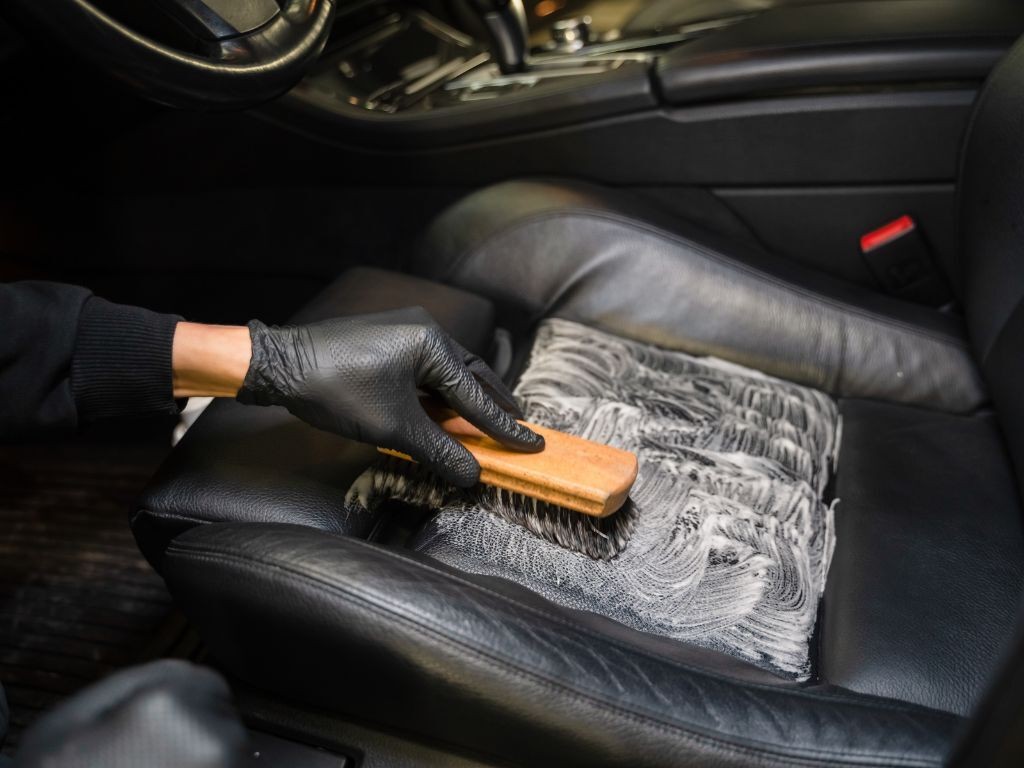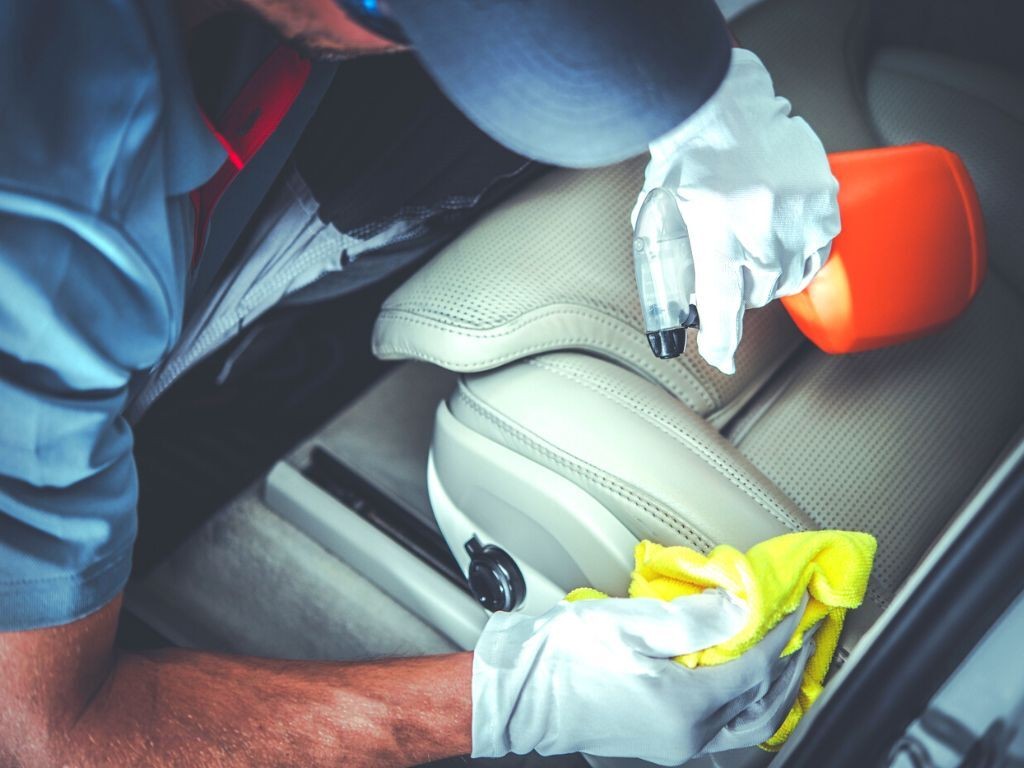How To Clean Leather Seats In Car properly is essential for maintaining their beauty and longevity. CARS.EDU.VN provides expert guidance and effective techniques for leather car seat cleaning and conditioning, ensuring your vehicle’s interior remains luxurious. Explore our site for more detailed car care advice, including leather care tips and the best car detailing practices.
1. Essential Steps to Clean Leather Car Seats
Maintaining the pristine condition of your car’s leather seats involves a few key steps. Begin by gathering your materials: several clean microfiber cloths, a specialized leather cleaning solution, a vacuum cleaner, and a leather conditioner. Follow these steps for a thorough cleaning process, as recommended by CARS.EDU.VN.
- Step 1: Apply the Cleaning Solution: Gently apply your chosen leather cleaning solution to the seats.
- Step 2: Scrub and Wipe: Use a detailing brush to scrub the leather, then wipe it dry with a microfiber towel.
- Step 3: Condition the Leather: Protect the leather by applying a conditioner.
- Step 4: Allow to Cure: Let the conditioner cure for the recommended time to ensure the leather is fully moisturized.
This systematic approach will not only clean your seats but also protect them, ensuring they remain supple and resist wear and tear. Regular leather care helps prevent discoloration, wrinkles, and cracking.
2. Detailed Guide to Cleaning Your Leather Seats
To ensure a thorough cleaning without damaging your leather, follow these detailed steps. This process is designed to gently yet effectively remove dirt and grime, keeping your car’s interior looking its best.
2.1. Applying the Leather Cleaning Solution
Once you’ve selected a leather cleaner suitable for your car, apply it directly to the leather seats and other leather surfaces in the car, such as the center console and dashboard. Allow the solution to sit for approximately 30 to 60 seconds. This dwell time allows the cleaner to break down contaminants on the leather surface, making them easier to remove.
When cleaning leather dashboards or door panels, apply the solution in small sections or directly onto a microfiber towel to avoid overspray. If overspray occurs, wipe it off immediately with a damp cloth.
2.2. Scrubbing with a Detailing Brush
Dampen your detailing brush with water and gently scrub the leather seats to create a foamy lather. This process helps loosen tough stains and embedded dirt, making them easier to wipe away.
For particularly stubborn stains, consider using a power drill with a soft white bristle head. Use it carefully to lightly scrub the seats and hard plastic surfaces. Ensure the brush is soft enough to avoid scratching the leather.
2.3. Curing and Wiping Off Excess
After scrubbing, use a clean, damp microfiber towel to wipe off the cleaning solution. This removes the excess cleaner and lifts away the remaining dirt. Ensure the seats do not remain damp for too long to prevent water spots or damage.
2.4. Conditioning the Leather
Once the seats are clean and dry, apply a leather conditioner directly to the leather, similar to how you applied the cleaner. Allow the conditioner to cure for a few minutes, then use a clean microfiber towel to wipe off any excess. The leather should feel supple, not greasy.
If some areas still feel dry, repeat the conditioning process to ensure complete moisturization and protection, particularly in older vehicles with neglected leather.
3. Choosing the Right Leather Cleaning Products
Selecting the right cleaning products is crucial for maintaining your leather seats. The market offers a variety of options, from store-bought solutions to DIY alternatives. Consider your preferences, budget, and the specific needs of your car’s leather when making your choice.
3.1. Store-Bought Leather Cleaners
Store-bought leather cleaners are formulated with specific ingredients designed to gently and effectively clean leather surfaces. Here are some popular options:
| Product | Description | Features |
|---|---|---|
| Leather Honey | A thick, honey-textured cleaner ideal for restoring worn leather seats. | Non-toxic, water-repellent, suitable for old leather. |
| Chemical Guys Sprayable Leather Cleaner and Conditioner | A pH-balanced cleaner that cleans and conditions leather in one step. | Preserves leather strength, durability, and appearance, removes dirt and oils, eliminates the need for separate conditioning. |
| Carfidant Ultimate Leather Cleaner | A gentle cleaner with a less aggressive chemical mixture, suitable for those with sensitivities. | Free of color dyes, leaves no scent, ideal for allergy sufferers. |



3.2. DIY Leather Cleaning Solutions
For those who prefer natural alternatives, DIY solutions can be effective for light cleaning. These options use common household items:
| Solution | Ingredients | Application | Benefits |
|---|---|---|---|
| Vinegar | White vinegar and water (1:1 ratio) | Spray on the seat and wipe with a clean, dry cloth. | Antibacterial properties, gentle on leather. |
| Baking Soda | Baking soda and water (make a paste) | Apply the paste to the seat, let it sit for a few minutes, then wipe off with a damp cloth. | Absorbs dirt and moisture, requires conditioning afterward. |
| Rubbing Alcohol | Rubbing alcohol | Use a cotton ball or lint-free cloth to apply to stains, then clean off the alcohol with a liquid dish soap solution and warm water. | Effective for blotting stains, requires follow-up cleaning to remove residue. |
4. Selecting Leather Conditioners
Conditioning leather seats is essential to prevent cracking and maintain their look. Conditioners keep the leather supple and protect it from environmental factors.
4.1. Store-Bought Leather Conditioners
Store-bought conditioners are formulated to moisturize and protect leather effectively. Here are some recommended options:
| Product | Description | Features |
|---|---|---|
| Obenauf’s Heavy Duty LP | Natural oils that protect car seats from cracks and tears. | All-natural ingredients, suitable for those preferring natural products. |
| Bick 4 Leather Conditioner | Does not darken the leather after application, ideal for maintaining the leather’s original color. | Wax-free, ensures leather pores do not seal up. |
| Meguiar’s G18616 Gold Class Leather Conditioner | Combines moisturizing oils and aloe to maintain the seat’s original look. | Provides UV protection to prevent aging and fading, great for sunny climates. |
4.2. DIY Leather Conditioners
DIY conditioners offer natural alternatives to maintain leather’s moisture and flexibility. Here are some popular choices:
| Solution | Ingredients | Application | Benefits |
|---|---|---|---|
| Coconut Oil | Coconut oil | Apply a small amount to a microfiber cloth and rub it into the leather. Let it sit for a few minutes, then wipe off excess. | Restores smooth appearance, effective for conditioning. |
| Beeswax | Beeswax | Apply a thick balm into the leather using your fingers. Rub it in and remove any excess with a microfiber towel. | Protects against mold and bacteria, restores water-resistant qualities. |
| Flaxseed Oil | Flaxseed oil | Apply a small amount to a microfiber cloth and rub it into the leather. Let it sit for a few minutes, then wipe off excess. | Provides a beautiful shine, protects against humidity damage, unlikely to cause allergies. |
5. Maintaining Leather Seats: A Comprehensive Guide
Maintaining leather seats involves more than just occasional cleaning; it requires a consistent approach to care and protection. Regular maintenance can significantly extend the life and beauty of your car’s interior.
5.1. Regular Cleaning Schedule
Establishing a regular cleaning schedule helps prevent dirt and grime from accumulating and causing damage. Aim to clean your leather seats every two to three months, or more frequently if you notice excessive dirt or spills.
5.2. Immediate Spill Response
Address spills immediately to prevent staining and damage. Use a clean, dry cloth to blot the spill, working from the outside in to avoid spreading the liquid. Follow up with a leather cleaner if necessary.
5.3. Protecting from Sunlight
Prolonged exposure to sunlight can cause leather to fade and crack. Park in shaded areas or use a sunshade on the windshield to protect your seats from direct sunlight.
5.4. Avoiding Harsh Chemicals
Avoid using harsh chemicals, such as bleach or ammonia-based cleaners, on leather seats. These chemicals can strip the leather of its natural oils and cause irreversible damage.
5.5. Proper Conditioning
Regularly condition your leather seats to keep them supple and prevent cracking. Apply a leather conditioner every two to three months, or as needed, to maintain their moisture balance.
6. Tips for Tough Stains and Problems
Even with regular maintenance, tough stains can occur. Here are some tips for addressing common problems:
6.1. Ink Stains
For ink stains, try using rubbing alcohol on a cotton ball. Gently dab the stain, being careful not to spread the ink. Follow up with a leather cleaner and conditioner.
6.2. Grease Stains
For grease stains, sprinkle baking soda on the stain and let it sit for several hours to absorb the grease. Vacuum up the baking soda and follow up with a leather cleaner.
6.3. Water Stains
For water stains, dampen the entire seat with water to create an even appearance. Blot the seat with a clean, dry cloth and allow it to air dry. Follow up with a leather conditioner.
6.4. Cracking Leather
For cracking leather, regular conditioning is key. Apply a leather conditioner to the affected areas and massage it in gently. Consider using a leather repair kit for more severe cracking.
7. When to Seek Professional Help
While many leather cleaning and conditioning tasks can be done at home, there are times when professional help is necessary. Consider seeking professional assistance for:
- Extensive Stains: If you have severe or extensive stains that you cannot remove with home cleaning methods.
- Significant Damage: If your leather seats have significant damage, such as deep cracks or tears.
- Lack of Time or Expertise: If you lack the time or expertise to properly clean and condition your leather seats.
Professional detailing services have the tools and expertise to restore your leather seats to their original condition.
8. How to Choose a Professional Detailer
Choosing the right professional detailer is crucial for ensuring your leather seats receive the best possible care. Consider these factors when making your selection:
8.1. Reputation and Reviews
Check online reviews and ask for referrals to gauge the detailer’s reputation. Look for detailers with consistently positive feedback and a track record of satisfied customers.
8.2. Experience and Expertise
Choose a detailer with extensive experience in cleaning and conditioning leather seats. Ask about their methods, products, and training to ensure they have the expertise to handle your car’s leather.
8.3. Services Offered
Ensure the detailer offers the specific services you need, such as leather cleaning, conditioning, and repair. Ask for a detailed list of services and a clear explanation of the process.
8.4. Pricing and Estimates
Obtain estimates from several detailers and compare their prices and services. Be wary of prices that seem too good to be true, as they may indicate subpar workmanship or materials.
9. Innovations in Leather Care Technology
The field of leather care is continually evolving, with new technologies and products emerging to enhance cleaning and protection.
9.1. Nano-Coating Technology
Nano-coating technology involves applying a thin layer of nanoparticles to the leather surface, creating a protective barrier against stains, UV rays, and wear. These coatings can extend the life of your leather seats and make them easier to clean.
9.2. Self-Cleaning Leather
Some manufacturers are developing self-cleaning leather that repels dirt and liquids. These innovative materials can reduce the need for frequent cleaning and maintenance.
9.3. UV Protection Films
UV protection films can be applied to car windows to block harmful UV rays and prevent fading and cracking of leather seats. These films can significantly extend the life of your car’s interior.
10. Frequently Asked Questions (FAQs)
Here are some frequently asked questions about cleaning leather seats in cars:
-
What should you not clean leather with? Avoid harsh chemicals like bleach, ammonia, and strong detergents, as they can damage the leather.
-
Can you use car wax on leather seats? No, car wax is not suitable for leather seats. Use a dedicated leather conditioner instead.
-
How often should you clean leather seats? Clean your leather seats every two to three months, or more frequently if needed.
-
How do I keep my leather seats from cracking? Regularly condition your leather seats, protect them from sunlight, and avoid harsh chemicals.
-
What is the best DIY leather cleaner? A mixture of vinegar and water (1:1 ratio) can be used as a gentle DIY leather cleaner.
-
Can I use baby wipes on leather seats? While baby wipes may seem convenient, they can contain chemicals that are harmful to leather. It’s best to use a cleaner specifically designed for leather.
-
How do I remove odors from leather seats? Baking soda can be used to absorb odors from leather seats. Sprinkle baking soda on the seats, let it sit for a few hours, and then vacuum it up.
-
Is it safe to use a steam cleaner on leather seats? Steam cleaners can be used on leather seats if done carefully. Use a low setting and keep the nozzle moving to avoid overheating the leather.
-
How can I prevent my leather seats from getting dirty? Use seat covers to protect your leather seats from dirt and spills. Regularly vacuum and wipe down the seats to prevent buildup.
-
What are the benefits of using leather conditioners? Leather conditioners help to moisturize the leather, prevent cracking, and protect against UV damage, keeping your seats looking new.
Maintaining your car’s leather seats requires time, effort, and the right resources. If you find this task daunting, consider seeking professional help. At CARS.EDU.VN, we’re dedicated to providing you with expert advice and services for all your car care needs. Whether you need detailed cleaning instructions or professional detailing services, we’re here to help.
For top-notch leather seat care and other car detailing services, contact us at 456 Auto Drive, Anytown, CA 90210, United States. Reach out via Whatsapp at +1 555-123-4567 or visit our website cars.edu.vn for more information. Let us help you keep your car looking its best!
By following these guidelines, you can maintain the beauty and longevity of your car’s leather seats, ensuring a comfortable and luxurious driving experience.